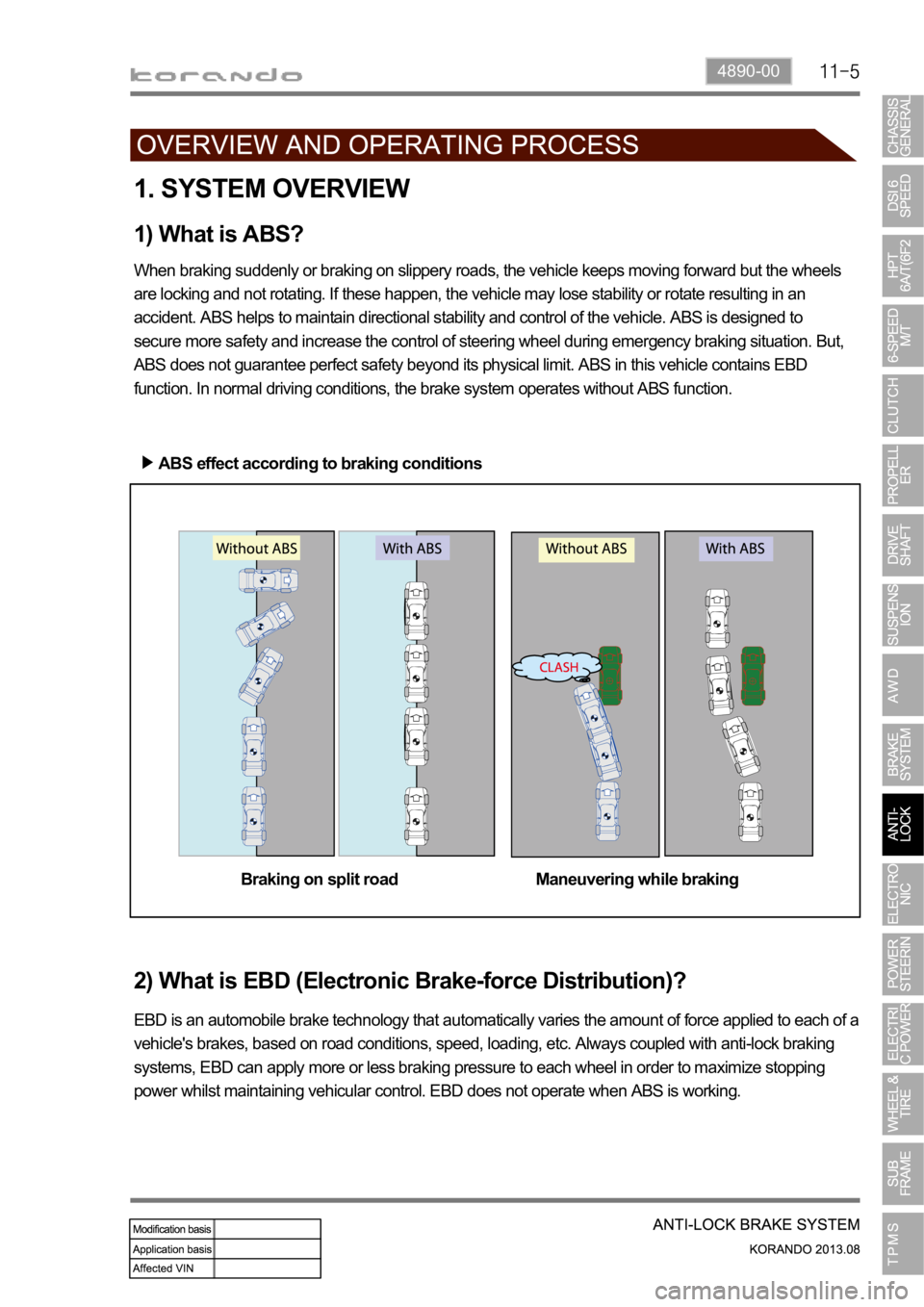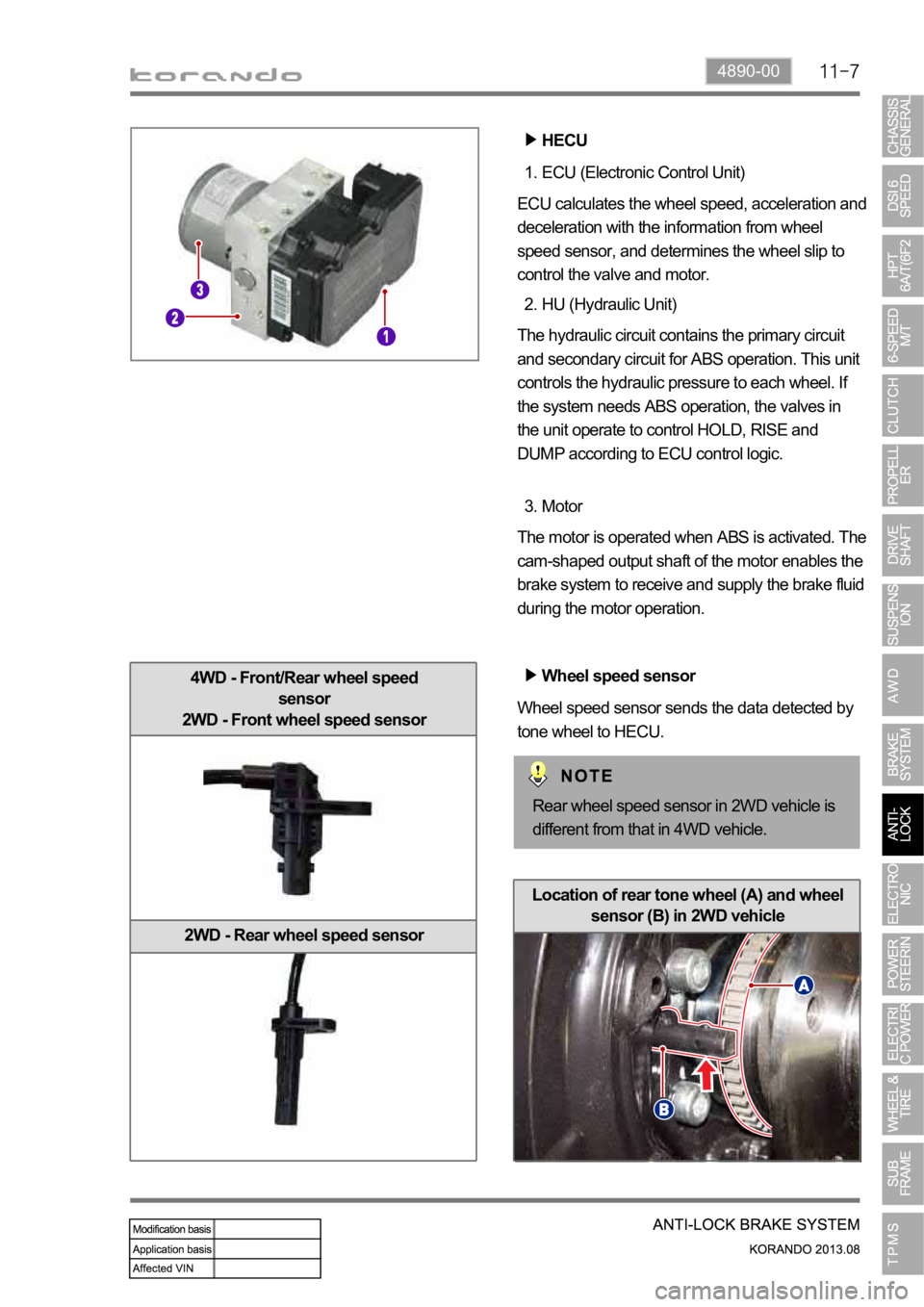Page 1093 of 1336
Pad guide bolt:
25.5~30.4Nm
Brake hose bracket
mounting bolt (12 mm):
9.8 ~ 12.8Nm
Air breather screw: 8.8 ~
10.8Nm
Caliper mounting bolt
(19mm x 2EA):
83.3 ~ 102.9Nm
Brake hose bolt
(12 mm):
19.6 ~ 29.4Nm
Wheel disc
Brake caliper
Brake hub
Brake disc
Knuckle Drive shaft Brake hoseBrake pad
Shock absorber
Brake disc
Back plate
Knuckle
2. SECTIONAL DIAGRAM
Front disc brake
Page 1094 of 1336
4850-00
Rear disc brake
Caliper
Brake hose
Brake disc
KnuckleWheel disc
Brake hub
Brake disc
Fastener Tightening torque Remark
Brake pad guide bolt 25.5 ~ 30.4Nm 14 mm x 2EA
Brake caliper mounting bolt 52.9 ~ 63.7Nm 17 mm x 2EA
Brake hose bolt 19.6 ~ 29.4Nm 12mm
Brake hose bracket mounting bolt 9.8 ~ 12.8Nm 12mm
Air breather screw 8.8 ~ 10.8Nm -
1) Tightening torque
Page 1099 of 1336
4890-00
1. SPECIFICATION
Unit DescriptionSpecification
ABS ESP
HECUClock frequency 32 MHz 50 MHz
Memory 128 KB 512 KB
Switch Orifice Orifice
Wheel speed
sensorABS / ESP CBS
Operating temperature
Operating frequency 1 to 2,500 Hz 1 to 8,000 Hz
Operating voltage 4.5 to 16 V 3.3 to 18 V
G-sensor ABS CBS / ESP
Operating voltage 4.75 to 5.25 V N/A
Operating temperature
Operating range -1.5 to 1.5 g
Output voltage 0.5 to 4.5 V
Page 1100 of 1336
ABS / ESP CBS
Circuit diagram of wheel speed sensor
Page 1101 of 1336

4890-00
1. SYSTEM OVERVIEW
1) What is ABS?
When braking suddenly or braking on slippery roads, the vehicle keeps moving forward but the wheels
are locking and not rotating. If these happen, the vehicle may lose stability or rotate resulting in an
accident. ABS helps to maintain directional stability and control of the vehicle. ABS is designed to
secure more safety and increase the control of steering wheel during emergency braking situation. But,
ABS does not guarantee perfect safety beyond its physical limit. ABS in this vehicle contains EBD
function. In normal driving conditions, the brake system operates without ABS function.
2) What is EBD (Electronic Brake-force Distribution)?
EBD is an automobile brake technology that automatically varies the amount of force applied to each of a
vehicle's brakes, based on road conditions, speed, loading, etc. Always coupled with anti-lock braking
systems, EBD can apply more or less braking pressure to each wheel in order to maximize stopping
power whilst maintaining vehicular control. EBD does not operate when ABS is working. ABS effect according to braking conditions
Braking on split road Maneuvering while braking
Page 1102 of 1336
3. G-sensor (for 4WD)
Located on the floor under
parking brake bracket in center
console.4. Rear wheel speed sensor
(for 2WD)
Located on knuckle. The
appearance is different from that
for 4WD.4. Wheel speed sensor
(for 4WD)
Located on knuckle. The
appearance of front sensor is
same with rear sensor.
2. ABS warning lamp
EBD warning lamp (ABS warning lamp +
Brake warning lamp)1. ABS hydraulic device and control unit
Located under the power steering fluid reservoir and
contains the pressure sensor.
2. COMPONENT
Page 1103 of 1336

4890-00
4WD - Front/Rear wheel speed
sensor
2WD - Front wheel speed sensor
2WD - Rear wheel speed sensor
ECU (Electronic Control Unit) 1.
ECU calculates the wheel speed, acceleration and
deceleration with the information from wheel
speed sensor, and determines the wheel slip to
control the valve and motor.
HU (Hydraulic Unit) 2.
The hydraulic circuit contains the primary circuit
and secondary circuit for ABS operation. This unit
controls the hydraulic pressure to each wheel. If
the system needs ABS operation, the valves in
the unit operate to control HOLD, RISE and
DUMP according to ECU control logic.
Motor 3.
The motor is operated when ABS is activated. The
cam-shaped output shaft of the motor enables the
brake system to receive and supply the brake fluid
during the motor operation.
Wheel speed sensor
Wheel speed sensor sends the data detected by
tone wheel to HECU.
HECU
Rear wheel speed sensor in 2WD vehicle is
different from that in 4WD vehicle.
Location of rear tone wheel (A) and wheel
sensor (B) in 2WD vehicle
Page 1104 of 1336
G-sensor (only for 4WD)
For the vehicle with the ABS, a speed difference
between the wheels is not noticeable as all the
wheels are slipping during abrupt braking.
Therefore, the vehicle needs the speed
information from other sensors other than the
wheel speed sensor. On the 2WD vehicle, there
is not large difference between the vehicle speed
reduction and actual wheel speed reduction in
the event of braking since the driving wheels are
in the front. So, the ABS HECU can control the
vehicle, based on a calculation value. But, on the
4WD vehicle, if a speed reduction occurs in the
front or rear of the vehicle, it affects the other side
wheel. In other words, braking the rear wheels
induces also a large speed reduction in the front
wheels. The longitudinal acceleration sensor is
used for this case. It controls the ABS by using
the signals from the sensor during abrupt braking
and acceleration.
G-sensor